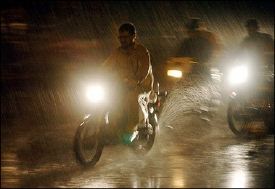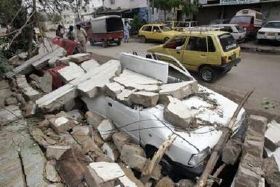Imagine 42 degrees celsius (107 degrees Farenheit) weather, no electricity, no fans, high humidity, no drinking water, and knee deep water on streets. Now imagine living through that for more than 24 hours. Terrible!
 That is precisely what most Karachiites have been going through for more the past 2 days. A huge monsoonal storm hit the city yesterday, followed by torrential rains. And then the infrastructure of the city that had already suffered several major blows in the past 2 months simply came crashing down. The city now sits in a giant puddle, surrounded by fallen trees, billboards, traffic lights, and rooftops.
That is precisely what most Karachiites have been going through for more the past 2 days. A huge monsoonal storm hit the city yesterday, followed by torrential rains. And then the infrastructure of the city that had already suffered several major blows in the past 2 months simply came crashing down. The city now sits in a giant puddle, surrounded by fallen trees, billboards, traffic lights, and rooftops.
Due to the severity of the storm, several trees were pulled out of the ground and are now left stretched across streets, many large bill boards fell on top of passing cars and people, electricity wires were found dangling from the poles leading to several people dying of electrocution, roofs of poorly constructed homes fell killing the residents, rain-related traffic accidents led to further deaths, and now people are suffering without electricity and proper transportation in the maddening heat. Reports are indicating that more than 50 people have died and more than 200 have been injured in Karachi already in the aftermath of the storm. Even those who have lived in the city and watched many monsoons go by are claiming this storm to be among the worst they have weathered. It seems the first wave of the storm has passed by but the city is still struggling to play catch up from all the destruction that it caused.
Karachi has suffered every year in the summer – but this summer has truly been an exception. Loadshedding, whereas practiced for at most a few hours a day in other parts of the country, has been extended to over 10-12 hours each day in Karachi. At least in one part of Karachi, Gulshan Iqbal, residents have had electricity for barely 3-4 hours in the past 48 hours. They have run out of clean water and people are borrowing water from their neighbors who have electricity generators to operate their underground pumps. If one was to take a chopper and fly above those areas at night, one would see most rooftops dotted with chaarpaais. People are routinely taking to the roofs at night to find some air to sleep in.
It is no surprise that there are agitated demonstrations on the streets in almost all parts of the city, resulting in burning of maintenance vehicles, other cars, and of KFC franchise stores. Those with job i n the morning are barely getting a few hours of sleep each night, those living in tall flats and apartments have no roofs to go to, the sick and the elderly are suffering, and food/milk is rotting in their refrigerators. Even those with some influence are suffering. Portable electricity generators have given up in this heat. Others simply can’t afford one that can power major equipment, or can’t afford the fuel to run them 10 hours a day. Given the generator usage in the past month or so in Karachi, I would certainly want our environmental monitoring stations to report the increase in carbon monoxide, ozone and particulate emissions in the city.
 Where is the administration amidst all of this mess? There have been pronouncements on TV (it is strange that due to the electricity shortage, I am able to have better access to news on Pakistan TV stations while living in the US than my own family that lives in Pakistan) that the City Nazim has established an emergency cell in his office, but results are yet to be seen. When residents of one area drove to the nearby KESC office to at least learn when to expect the electricity back, they found a big lock outside the door. Fearing their lives, and having no real plan of action, many KESC workers have fled the offices.
Where is the administration amidst all of this mess? There have been pronouncements on TV (it is strange that due to the electricity shortage, I am able to have better access to news on Pakistan TV stations while living in the US than my own family that lives in Pakistan) that the City Nazim has established an emergency cell in his office, but results are yet to be seen. When residents of one area drove to the nearby KESC office to at least learn when to expect the electricity back, they found a big lock outside the door. Fearing their lives, and having no real plan of action, many KESC workers have fled the offices.
Here is what Dawn had to report on the electricity situation:
According to sources, fire broke out in Orangi grid station neutralising seven other grid stations that plunged major part of the city into darkness. Gulshan-i-Iqbal, Gulistan-i-Jauhar, Federal B Area, North Karachi, Orangi and the adjoining areas remained without power for several hours. This was in addition to sniping of wires and uprooting of electric poles in many localities.
In addition, KESC faced generation shortage as its flagship Bin Qasim was generating only 595MW by sunset and Korangi Thermal Power Plant along with Tapal were off. Supply from Hubco was also interrupted due to tripping in Valika. Owing to this the KESC was only receiving 270MW from WAPDA from Jamshoro Circuit instead of 700MW. The KESC Director Operations claimed that grid stations and feeders had been closed to protect the system from rains.
With the first drop of rain the KESC shut down its 35 grid stations and more than 400 feeders, 30 per cent of the feeders were closed due to tripping while the rest were closed as a precautionary measure. The KESC Director Operations claimed that except for 10 grid stations all were reactivated. But the areas served by the reactivated grids were still in darkness. “This could be due to local faults,� he claimed, however, he had no answer as to who would rectify those faults.
While uprooted poles, broken electric wires were lying on roads, the KESC was still unable to identify them and take measures to secure the area.
Is is shameful that in the largest metropolitan city of the country, people are having to live in these conditions. Everyone that I speak to is on the verge of giving up hope for the city. It appears the administrative system has collapsed, or has been rendered unable to do much in terms of providing relief. The nature and cause of the massive electricity shortage is a topic of another post all by itself, but right now there is a great need for emergency efforts to make sure the elderly, the children, and the ill are provided care in these difficult times. The weather is playing havoc, and the lack of basic amenities is multiplying the suffering.



















































Boy Karachi’s had a bad year!
It’s like a microcosm of Pakistan. With every tragedy – nature made or man made – the hollowness of our claims to development & modernization become apparent. 200 dead! And I bet the opposition is grinning right now at another opportunity to blame and critisize (albeit justifiably) the govt.
http://weather.yahoo.com/img/asia_sat_440_mdy_y.ht ml
This map shows the huge system sitting off the coast of Karachi and is available to anyone who has access to the net (I am sure there are better maps available from other web sites). I have been watching this for 3 days, and it has moved very little during this time (yes I admit, I am a weather bum). However it is our level of insensitivity to what is going on around us (both at the individual level and at the institutional level; be it the meteorological dept or all other concerned city departments), which lead to no warning of this approaching system at any level. With fair warnings atleast some loss of life due to falling billboards could have been prevented.
My guess is the Govt. is not even concerned about all this since there are too many other political matters which need resolving.We should not expect so much from our Govt. they have already done so much for us ! May 12th just being a highlight.If killing of Pakistanis by guns does not matter then this is just a natural death for them.
Over 200 people have died in Karachi in a single day, but has anyone here heard a single statement of grief coming out of ‘camp-office’?
I guess the President (like Miranshah and Waziristan) has gotten used to seeing Karachiites being killed like bugs.
Ive been thinking of this for sometime but never brought it forward but I think now since ATP has matured a bit, its a good time to start brainstorming on various development projects like making a public library, or building a self sustainable public toilet or in this case produce energy????
Come on ATP, we are not just about talk!